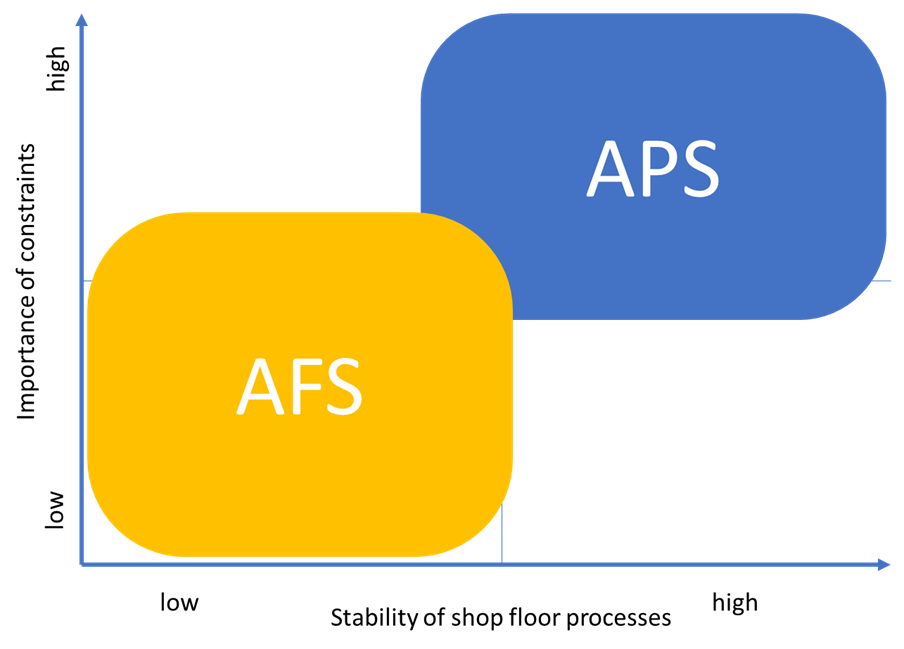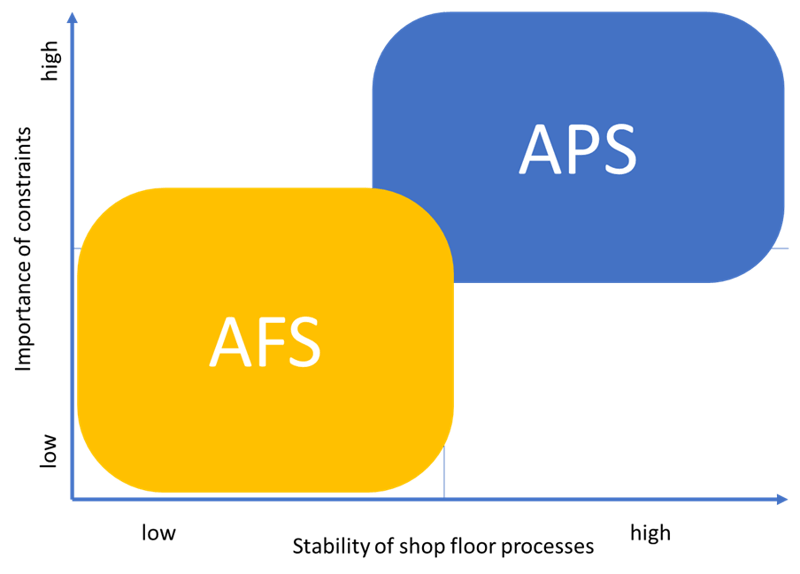Menu

The acronym APS is well-known in the world of production scheduling. It stands for Advanced Planning and Scheduling. But do you know what the acronym AFS means? It stands for Automatic Finite Scheduling. Both methods aim to calculate a production schedule for the planner and are based on data from resources, jobs, material availability, and routings. And do you know why is a scheduling system, based on the AFS method the significantly better alternative for SMB manufacturers who operate in a high-mix low-volume (HMLV) environment? Let me tell you that there are several reasons for this.
Both APS and AFS have the term "Scheduling" in their names. Hence it makes sense to define what “scheduling” is all about, in a first step.
The meaning of the term "scheduling" becomes easily clear when you confront it with the meaning of the term "planning".
Now that you know the difference between "scheduling" and "planning," the next step is to describe what makes the APS different from the AFS.
Let's start with APS:
Let's turn to AFS:
Taking these differences as a basis, there are two determinants that ultimately decide whether the use of APS or AFS is more effective for the respective use case:
- A complex algorithm only makes sense if I have reasonably stable processes and the quality of my input data is good or can be reliably estimated. Accordingly, an APS is expedient(er)
- If this is not the case, then the long calculations and the more complex approach do not add any value. Accordingly, a quick calculation via AFS is expedient(er)
- If there are additional cost-driving constraints that are more decisive for financial success (e.g. consideration of criteria for minimizing the set-up costs in one or multiple stages) than an early delivery date, hence when it is preferable to deliver jobs at a later date but produce it more cost-effectively, then the corresponding APS functionality provides added value.
- If this is not the case, AFS is dominant because it's faster and easier to handle.
If this is brought into a simple graph, then the recommended areas for implementing one of the two software solutions are as follows:

Finally, it now makes sense to highlight the crucial particularities of HMLV manufacturers. Commonly these are:
Characterization of job shops - check out here: What is flow shop scheduling vs job shop scheduling?
Bringing together all these findings, it can be deduced that the use of an AFS is clearly preferable for HMLV manufacturers.
In addition, there is another decisive advantage that has so far been left out of the previous analysis: the costs of introducing and running the corresponding product. Due to the lower complexity, an AFS is both easier and therefore cheaper to implement and to use on an ongoing basis.
just plan it is a production scheduling software plus scheduling tools & best practices to help high-mix low-volume make-to-order manufacturers gain transparency and control over their shop operations. The software plus its methodology is used by thousands of people around the globe. They consistently achieve improved on-time deliveries, shorter lead times, and better utilization of their resources.
As just plan it is not just software, but a lot of processes and best practices, we recommend that you start with an exploratory meeting. If we agree that there is a fit between your requirements and our approach, we'll build a prototype for you.
Hence, it all starts with a meeting. Book that meeting now.
These Stories on Machine shop scheduling
Made with by BOYUM IT SOLUTIONS GmbH (Copyright © 2024) Read our Privacy Policy & Terms of Service
No Comments Yet
Let us know what you think